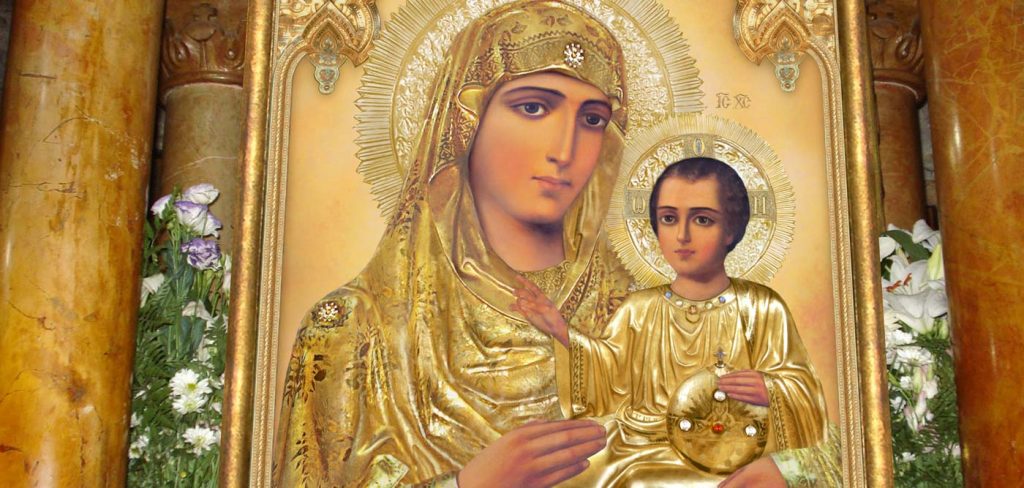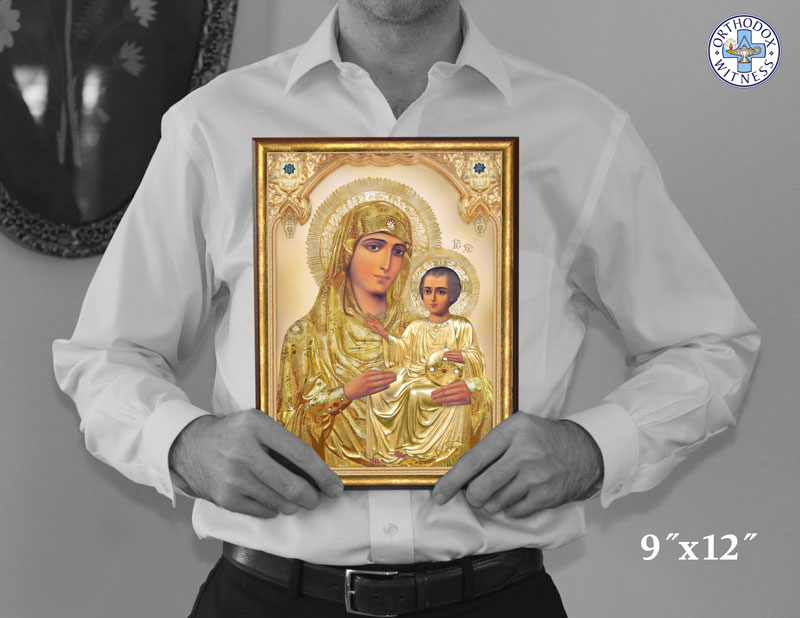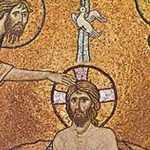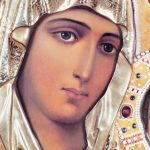
THE AKATHIST HYMN: History, Significance, Analysis
The Akathist Hymn, the Salutations to the most-holy Theotokos, is one of the most beloved Services of the Orthodox Church. Its popularity is due to its theme, its beautiful melodies and its poetic expression and structure. It constitutes the crown jewel of Orthodox hymnology. The inspired composer, with incomparable imagery, rhetorical skill and spiritual loftiness praises the great mystery of Incarnation and the holy Virgin, who became the Instrument of our salvation.
Historical Background
The Hymn has been studied over the centuries, yet, despite all the attention it has received by many scholars, many questions remain unanswered, with “who is the composer” and “what is the time of composition” being the main ones. As authors most often mentioned are Romanos the Melodist (6th Century), Sergios Patriarch of Constantinople (7th Century), and St. Photios (9th Century), among others.
Why is it called Akathist? Because during the chanting of the Hymn the faithful remained standing (Akathistos in Greek means “non-sitting”). They still do. This was a unique characteristic of this particular Ode, contrary to the custom of sitting during the chanting of other Odes. Why the difference? It is understood as an expression of thanksgiving to the most holy Theotokos for having saved the “City” (Constantinople) from being sacked by the enemies.
To those of Greek extraction the Akathist is of added significance, in that it relates to the Greek Nation’s historic events of its War of Independence of 1821. We should also point out that because of the historic significance of the Hymn, tied repeatedly to events in the history of the Greek Nation, a new prelude was composed, full of doxology and entreaty, known by everyone —the most famous “Ti Ypermaho”: “To you, Invincible.” This prelude was most likely composed by Patriarch Sergios.
A few sources for The Akathist Hymn text:
Religious Significance
But why is it chanted during the Great Lent, since the breaking of the various “sieges” with which this Hymn has been associated took place at other times? It is probably chanted at this time as a tribute to the Most Holy Theotokos due to the fact that the Feast of the Annunciation falls always during Great Lent. By breaking it into parts, the celebration lasts even longer. That’s why Saturday was chosen (remember, the day starts from the sundown of the previous day) –because Saturdays and Sundays are the only days in which a joyful event can be commemorated during Great Lent.
Originally the Hymn was part of the Matins Service. For the convenience of the faithful it was transferred to the evening before, attached to the Small Compline. In monasteries it is read daily. Monks recite it by heart.
Analysis of the Akathist Hymn
What is the Akathist Hymn? It is a poem, comprised of a prelude (the Kontakion “To Prostachthen Mystikos”) and 24 stanzas, one for each of the letters of the Greek Alphabet. In other words, the Akathist consists only of that part which is intoned by the Priest. The odd numbers follow the same pattern, their characteristic being that they are comprised of six double addresses to the Most holy Mother of God, beginning with “Hail,” or “Rejoice,” in Greek “χαῖρε, haire”, therefore their popular name of “Hairetismoi,” Salutations. They all have the same refrain, which is the concluding line: “Haire Nymphi Anymphefte,” literally “Hail, Groomless Bride”. The even stanzas are shorter and are patterned after the second Kontakion. Their refrain is “Alleluiah.” The Akathist can rightly be called and is our “Hymn of Joy,” with its motif being the joyous event of the Incarnation, accented by the unceasing cries of “Rejoice,” “Rejoice”: “Rejoice, for though you joy will shine forth!”
Theme of the Hymn is the Mystery of the Incarnation, with emphasis to its beginning, the Annunciation of the Good News to the Theotokos. The prelude is a summary of the entire Hymn. The first four stanzas develop this theme, while the next eight stanzas (through M) go over the historical events:
- Visit to Elizabeth - E
- Joseph’s doubts - Z
- Christ’s birth - H
- the Star - Θ
- the Adoration of the Magi - I
- their departure - K
- Christ in Egypt - L
- and Symeon’s Meeting with the Messiah - M
The other half of the Ode (N - W) constitutes a theological elaboration of the Mystery of Incarnation:
- The new Creation glorifies God - N
- the new, wondrous birth urges people to alienate themselves from the world - Ξ
- the Logos was on earth, but also remained in heaven - O
- the Angels were amazed at the divine plan of salvation - P
- the wise of the world are unable to explain the mystery of the virginal birth - R
- the shepherd-God, becomes lamb-man in order to save the world - S
- the Virgin becomes the protection of the faithful - T
- no hymn can pay an adequate tribute to the Incarnate King - Υ
- the Holy Theotokos is the bright candle that guides to the knowledge of God - Φ
- Christ came to the world to bring grace and forgiveness - Χ
- the doxology to the Son is connected to the praise of the living temple, the Holy Theotokos - Ψ
- ending with the following admirable address to the Virgin - Ω
O ALL-HYMNED AND PRAISED MOTHER, who did bear Him who is holier
than all the saints: the most holy Logos:
In receiving our offering now,
do safeguard and rescue from all ills all of us
and do redeem and spare from future punishment
those crying out to you: Alleluia!
The hymn provides an explanation as to the reasons for which the holy Theotokos was addressed Κεχαριτωμένη, Full of Grace, by the Archangel Gabriel, as for example with verses,
- “Rejoice, for you are the Throne of the King”
- “Rejoice, for you prepare a port for our souls” and
- “Rejoice, for the heavenly realm rejoices with the earthly one”
Other verses express metaphorically her special place as the Mother of God:
- “Rejoice, Star revealing the Sun”
- “Rejoice, heavenly Ladder by which God descended”
- “Rejoice, mother of the Lamb and the Shepherd” and
- “Rejoice, tabernacle of God and Word”
Still other verses declare the results on humankind of such special place:
- “Rejoice, opener of the gates of Paradise”
- “Rejoice, access of mortals to God” and
- “Rejoice, through you we have been covered with glory”
Other images are taken from the Old Testament, and matched fittingly to the Theotokos, as for example,
- “Rejoice, fertile field growing a bounty of mercies”
- “Rejoice, sea who drowned the invisible Pharaoh” and
- “Rejoice, promised land”

The Akathist contains poetic images of incomparable beauty, but also of deep theological meaning. The holy Virgin through her “Yes,” her “Let it be to me according to your word,” through her acceptance of God’s will, became the instrument through which salvation for the human kind became possible. The recurrent images of the Hymn point to this reality:
- She is the Branch which produces the GRAPE
- She is the Field on which grows the WHEAT
- She is the Tree that bears the FRUIT
- She is the Altar on which lays the FOOD
- She is the Rock from which springs the WATER
- She is the Promised Land where we find the MILK & HONEY
- She is the baptismal Font in which we find the baptismal GRACE
- She is the Fold which keeps the LAMB
- She is the Treasury in which is found the TREASURE
- She is the Throne on which sits the KING
- She is the Chariot ridden by the RIDER
- She is the Candle which shines the LIGHT
- She is the Dawn announcing the DAY
- She is the Key which opens PARADISE
- She is the Gate leading to the KINGDOM
- She is the Ladder through which we climb to HEAVEN
- She is the Bridge that carries us to SALVATION
- She is the Dwelling where dwells the LORD
- She is the Bridal Chamber where awaits the BRIDEGROOM
In her womb took place the mystical and incomprehensible union of humanity and divinity. It is in her as well, where the union of our soul with our Creator is consummated. It is in her that our salvation is accomplished. How can we have the Fruit without the Tree? How can we have the Light without the Candle? That is why we honor and praise her: because, although she is not the Good News, she is definitely the Book on which the Good News was written. Although she is not the Joyful News of our salvation, she most definitely is the Bearer of such News.
May you deem us worthy, O holy Theotokos, to celebrate your Salutations in good health, for as many years as Your Son and our God grants to us. Amen.



